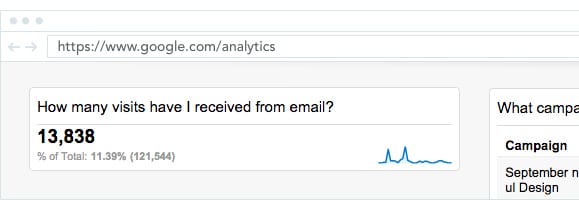When it comes to customer interaction, email is the Holy Grail of marketing communication.
That’s because done right, it produces phenomenal results. In fact, the ROI for email marketing can be as high as 4400%. That’s $44 for every dollar spent on an email marketing campaign.
What is email marketing ROI?
Return on investment (ROI) is a measure used to evaluate the efficiency and profitability of an investment. In this case, it is a measure of the profitability of email marketing.
Here’s the basic formula for calculating ROI: gained – spent/spent = ROI (expressed as a percentage).
As a marketer, every email marketing campaign must produce a healthy return—and you need to be able to calculate it easily.
Know your email marketing goals
Tracking your email marketing ROI is not as straightforward as it may seem. That’s because email is a versatile marketing strategy that can be used to achieve a number of goals such as:
- Raising brand awareness
- Lead nurturing
- Increasing sales and revenue
- Website traffic
Once you know the goal of your email marketing campaign, it becomes easier to calculate your ROI, since you’ll know the exact metrics to track.
How to calculate email marketing ROI
With the foundation laid, let’s get to the crux of the matter—calculating email marketing ROI.
How do you do that?
Calculate your spend
The first step in calculating your email marketing ROI is calculating how much you spend on your email marketing. This may seem simple, but it does have its complications.
The most obvious expense is your ESP, and luckily, this calculation is pretty straightforward. However, that alone will not give you a reliable result when calculating ROI, especially since there are other expenses to factor in—like time spent on email marketing.
This means you’ll need to calculate how much time each member of the team spends directly on email marketing and convert it into an hourly rate.
If all your email marketing expenditure goes to your ESP and your email marketer’s time, your total spend is ESP + team bandwidth.
Calculate your gain
Calculating how much your email campaign brings in is fairly easy, if you sell your goods online. If your ESP has Google Analytics integrated into the dashboard, it’s especially easy to trace every sale that comes from an email. This can be for a particular campaign or over a certain period of time.

Source: Campaign Monitor
So how do you calculate your gain?
The easiest way to go about this is to calculate the value of a lead. By using Google Analytics, you can trace every conversion that can be attributed to your email campaign, including website traffic. You can then multiply the number of conversions by the value of a lead to get the total revenue brought in by your email campaign.
Calculate your ROI
Having compiled all your data, you can then plug it into our equation:
(Gain – spent)/spent = ROI
Let’s say you pay $200/month for your ESP. In a year, that comes up to $2,400. You also have a marketer directly working on email campaigns for 2 hours, 5 days a week and at a rate of $16/hour. That amounts to $7,680 a year.
Your email marketing spend in a year is $7,680 + 2,400 = $10,080.
If the cost of your lead is $100 and your email campaign brings 300 leads/year, your total revenue from email becomes $30,000.
With all this data, you can then calculate your ROI as:
($30,000 – $10,080)/$10,080 = 197.6%
Does it matter?
Operating a business without knowing which strategy is profitable and which isn’t is a sure recipe for failure. That’s why, when you employ an email marketing campaign, you need to be able to calculate the ROI so as to know whether it’s bringing you revenue or draining from the business.
What now?
Now that you know how to calculate your email marketing ROI, calculate the ROI for your last campaign.
In order to improve it, here’s an article to help you improve your email marketing strategy.